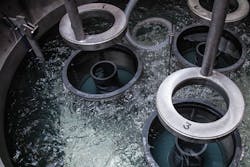Fresh, clean water is a rare commodity. Only 0.007 percent of the planet’s water is readily available to fuel and feed the world’s 7.6 billion people. And by 2030, it is estimated there will be approximately 8.2 billion people on the planet. This means that in just over 10 years from now, people need 30 percent more water, 40 percent more energy and 50 percent more food. According to the Rockefeller Foundation, by 2030, demand is predicted to outstrip supply by 40 percent. Water consumption has been growing at more than twice the rate of population growth for the last century. To mitigate this trajectory reaching an even higher point requires collective acceptance of the problem alongside collective action and sufficient investment in water recovery technologies. The fact that only 3 percent of the world’s wastewater is currently being reused provides promise for the future.
The high cost of food production
The majority of global water withdrawals — 70 percent according to the World Water Development Report — are due to agriculture, the largest consumer of water on the planet. Agricultural wastewater resource recovery represents a solution that also provides the benefit of lessening the wastewater strain placed on municipalities by ensuring polluted water is cleaned and, in certain cases, reused.
Food and beverage companies require water not only as a product ingredient, but also to run manufacturing processes. Moreover, with diets shifting from predominantly starch-based food to meat and dairy, which requires significantly more water, the problem only exacerbates. A fundamental shift is required on the industrial side of water usage, and innovation is being spawned from growing environmental regulations and a culture that is driving the adoption of sustainable practices through simple necessity.
Wastewater innovation that works
Thousands of companies in the marketplace are trying to solve the problems inherent in the treatment of wastewater. Aside from providing valuable resources, from clean water to phosphorous and nitrogen, wastewater is also a “dispatchable” source of energy. In other words, as an energy source, wastewater is available 24/7, 365 days a year, versus variable renewable energy sources such as solar and wind, which (storage aside) are contingent on climatic conditions to ensure consistent supply.
However, when it comes to “mining” the resources from wastewater, there is no silver bullet. The majority of technologies in the world are largely dependent on biology to separate the organics from wastewater. Under the right, narrow set of circumstances, biological wastewater treatment solutions can be effective ways to clean wastewater. However, the challenges lie in the management of bugs or microorganisms, which adds unpredictability and volatility to the process, in addition to requiring a great amount of energy and time.
Addressing brewery wastewater treatment without biology
By removing biology from the wastewater equation, most of the expense and hassles are eliminated. A new approach to primary wastewater treatment is a mechanical solution that requires minimal amounts of coagulants. The development of the wastewater resource recovery solution delivers results previously unseen in the industry. Working with dairies, breweries, wineries and food processors across the U.S., ClearCove demonstrates this approach in a project with a well-known regional brewer in Ohio.
The challenge
The brewery produces approximately 30,000 barrels (BBL) per year and growing, with plans to build an additional new facility. Its production will grow from 60,000 to 150,000 BBL/year, resulting in about 24,000 gallons per day (gpd) of wastewater initially, increasing to 50,000 gpd or more as production increases.
The wastewater from the brewery process needs to be treated before it is discharged to the municipal sewer line to eliminate costly surcharges based on biochemical oxygen demand (BOD) and total suspended solids (TSS). The brewery process wastewater has a BOD level of approximately 6,856 milligrams per liter (mg/l) and TSS of 700 mg/l. The current limits are 250 mg/l BOD and 275 mg/l TSS, which translates into BOD surcharges of more than $14,000 per month.
The solution
To address these challenges, the brewery installed ClearCove’s biology-free solids removal system integrated with a physical membrane secondary treatment process to enable the brewery to meet effluent requirements to potable water reuse levels. The brewery selected this solution for the following reasons: cost, surcharge elimination, sanitary compliance, ease of operation (does not require a full-time operator), minimal footprint (less than 1,200 square feet), expandability and flexibility in process variations versus a typical biological treatment solution.
The primary treatment system integrated physical ultrafiltration and reverse osmosis (RO) with a built-in clean-in-place package. It can treat up to 60,000 gpd, including recirculation. Full-system control allows the user to manage the entire process via one central control system. The brewery retained the option to add a second pass RO to drive the effluent to even cleaner standards for other water reuse options.
The system uses a pretreatment equalization and pH adjustment system and only a small amount of coagulant to achieve results without requiring cationic polymers. The effluent performance for this application is designed to achieve a target of less than 100 mg/l BOD5 and less than 1 mg/l TSS at a pH of 6.5 to 7.5 for 30,000 gpd (average five-day composite per quarter).
Sustainability return
The system uses about as much energy as a lightbulb left on for 24 hours. Annual surcharge savings are $134,000, net of $34,000 in electrical, chemical, and operations and maintenance costs. Electrical costs are only $9,280 (0.08/kilowatt hours).
Greg Westbrook is the CEO of ClearCove. His background spans several decades in international business. As president of Consumer Electronics at Flextronics (now Flex), Westbrook headed a global team that delivered consumer products to top-tier brands. Prior to that, he was a corporate officer at Kodak, where he gained international experience spanning 20 years. Westbrook is an alumnus of Rochester Institute of Technology and a member of the President’s Roundtable.




